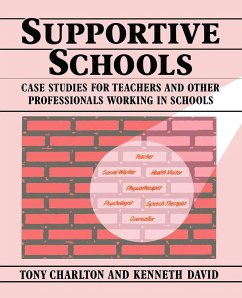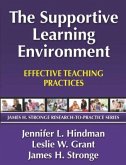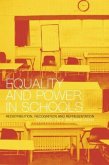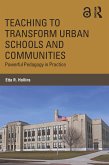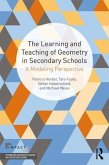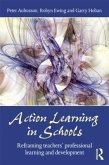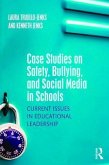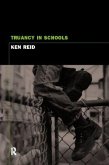Tony Charlton, Kenneth David
Supportive Schools
Case Studies for Teachers and Other Professionals Working in Schools
Tony Charlton, Kenneth David
Supportive Schools
Case Studies for Teachers and Other Professionals Working in Schools
- Broschiertes Buch
- Merkliste
- Auf die Merkliste
- Bewerten Bewerten
- Teilen
- Produkt teilen
- Produkterinnerung
- Produkterinnerung
Using 15 case studies, this book highlights the attempts being made by teachers and other professionals to meet the varied needs of pupils in mainstream and special schools. The emphasis is on providing practical examples which illustrate effective intervention strategies for use in particular situations. The case studies explore such diverse areas as disruptive behaviour, dyslexia, child abuse, deafness and epilepsy, as well as discussing the wider issues of personal and social education, disability and under-achievement.
Andere Kunden interessierten sich auch für
![Supportive Learning Environment, The Supportive Learning Environment, The]() Jennifer HindmanSupportive Learning Environment, The38,99 €
Jennifer HindmanSupportive Learning Environment, The38,99 €![Equality and Power in Schools Equality and Power in Schools]() Anne LodgeEquality and Power in Schools66,99 €
Anne LodgeEquality and Power in Schools66,99 €![Teaching to Transform Urban Schools and Communities Teaching to Transform Urban Schools and Communities]() Etta R. HollinsTeaching to Transform Urban Schools and Communities58,99 €
Etta R. HollinsTeaching to Transform Urban Schools and Communities58,99 €![The Learning and Teaching of Geometry in Secondary Schools The Learning and Teaching of Geometry in Secondary Schools]() Pat HerbstThe Learning and Teaching of Geometry in Secondary Schools64,99 €
Pat HerbstThe Learning and Teaching of Geometry in Secondary Schools64,99 €![Action Learning in Schools Action Learning in Schools]() Peter AubussonAction Learning in Schools61,99 €
Peter AubussonAction Learning in Schools61,99 €![Case Studies on Safety, Bullying, and Social Media in Schools Case Studies on Safety, Bullying, and Social Media in Schools]() Laura Trujillo-JenksCase Studies on Safety, Bullying, and Social Media in Schools63,99 €
Laura Trujillo-JenksCase Studies on Safety, Bullying, and Social Media in Schools63,99 €![Truancy and Schools Truancy and Schools]() Ken ReidTruancy and Schools75,99 €
Ken ReidTruancy and Schools75,99 €-
-
-
Using 15 case studies, this book highlights the attempts being made by teachers and other professionals to meet the varied needs of pupils in mainstream and special schools. The emphasis is on providing practical examples which illustrate effective intervention strategies for use in particular situations. The case studies explore such diverse areas as disruptive behaviour, dyslexia, child abuse, deafness and epilepsy, as well as discussing the wider issues of personal and social education, disability and under-achievement.
Hinweis: Dieser Artikel kann nur an eine deutsche Lieferadresse ausgeliefert werden.
Hinweis: Dieser Artikel kann nur an eine deutsche Lieferadresse ausgeliefert werden.
Produktdetails
- Produktdetails
- Verlag: Routledge
- Seitenzahl: 144
- Erscheinungstermin: 9. November 1990
- Englisch
- Abmessung: 235mm x 191mm x 8mm
- Gewicht: 284g
- ISBN-13: 9780333496190
- ISBN-10: 0333496191
- Artikelnr.: 21893789
- Herstellerkennzeichnung
- Libri GmbH
- Europaallee 1
- 36244 Bad Hersfeld
- gpsr@libri.de
- Verlag: Routledge
- Seitenzahl: 144
- Erscheinungstermin: 9. November 1990
- Englisch
- Abmessung: 235mm x 191mm x 8mm
- Gewicht: 284g
- ISBN-13: 9780333496190
- ISBN-10: 0333496191
- Artikelnr.: 21893789
- Herstellerkennzeichnung
- Libri GmbH
- Europaallee 1
- 36244 Bad Hersfeld
- gpsr@libri.de
Kevin Jones is Senior Lecturer in the School of Education at Nanyang Technological University, Singapore. Tony Charlton is Professor of Education at Cheltenham and Gloucester College of Higher Education. They are the co-editors of Learning Difficulties in Primary Classrooms (Routledge 1992).
Introduction; Attempts to meet the individual needs of a young child
entering infant school. A Home-School Liaison Teacher works with a
disadvantaged family to help a pre-school child evidencing poor speech and
language development. A disorganised child in a Primary School. A pupil
encounters difficulties in the movement learning area. The diagnosis and
support of a young child with special needs. 2 Matthew QUESTIONS SUPPORTIVE
INFORMATION AND MATERIAL 1 The Health Visitor's plan of action 2
Developmental tests used by a Health Visitor 3 Audiology and the Teacher
for the Deaf 4 Mother and toddler group 5 ENT consultant 6 District
handicapped teams and Handicap register 7 Checklist for Health Visitor
after birth of a child 8 Definitions of impairment, disability and handicap
9 Useful reading A change in a Primary School child's disruptive behaviour.
An examination of the possible reasons for the dramatic improvements in a
young boy's behaviour after his prior disruptive behaviour had caused real
concern both at home and in school. QUESTIONS SUPPORTIVE INFORMATION AND
MATERIAL 1 Behaviour modification 2 Useful reading An eight-year-old boy
with specific learning difficulties - dyslexia. QUESTIONS SUPPORTIVE
INFORMATION AND MATERIAL 1 Definitions of dyslexia 2 Information and
material 3 Publishers of specific learning difficulties material 4 Useful
games 5 Books that list useful resources including games 6 Useful addresses
7 Test materials 8 Useful reading 4 Jeremy 5 James Possible child abuse. A
teacher is concerned about an older Primary age child's physical injuries
and the possibility that he is being abused at home. The teacher encounters
the dilemma of making a decision about whether or not to share her concern
with others. QUESTIONS SUPPORTIVE INFORMATION AND MATERIAL 1 Useful
addresses 2 Types of abuse 3 Indications of possible abuse 4
Responsibilities and procedures 5 Cleveland Inquiry - a reminder 6
Estimates of abuse 7 The teacher's role 8 Considerations for parents 9 The
Children Act (1989) 10 Useful reading and training packs An epileptic
person fit for work. This deals with the Primary and Secondary School
career of a young girl with epilepsy, and her later adult work. QUESTIONS
SUPPORTIVE INFORMATION AND MATERIAL 1 Types of epilepsy 2 Helping
organisations 3 A teacher's guide to epilepsy 4 Critical comments from a
person with epilepsy 5 Useful leaflets 6 Addresses 7 Training packs 8
Useful reading A thirteen-year-old child in a special school has severe
learning difficulties. QUESTIONS SUPPORTIVE INFORMATION AND MATERIAL
Reference material 6 Patrick 7 Sally 8 Sandra A Primary Heads' In-Service
Training day, and their consideration of personal and social education in
the primary school. QUESTIONS SUPPORTIVE INFORMATION AND MATERIAL 1 A
selection of themes in personal and social education (PSE) 2 A random list
of possible PSE topics 3 A checklist of PSE themes 4 Useful reading A
consideration of how the needs of a severely physically disabled youngster
can be provided for within a mainstream Secondary School. QUESTIONS
SUPPORTIVE INFORMATION AND MATERIAL 1 General information 2 Useful contacts
for parents 3 Useful addresses 4 Other useful organisations 5 Useful
references A computer can help with the speech problems of a Secondary
School child. QUESTIONS SUPPORTIVE INFORMATION AND MATERIAL 1 Useful
programme 2 Useful addresses 3 Useful reading A thirteen-year-old girl with
a disturbed home background is helped through counselling to be less
passive and withdrawn. QUESTIONS SUPPORTIVE INFORMATION AND MATERIAL 1
Definitions of counselling 9 Twinely District 10 Daniel 11 Brian 12 Wendy 2
Listening 3 Interviewing pupils - normal problems 4 Referral agencies 5
Blocks to listening 6 Useful reading A route for a misfit. This case study
illustrates how a Secondary School's pastoral care provision and practices
can fail to help some youngsters. QUESTIONS SUPPORTIVE INFORMATION AND
MATERIAL 1 The Youth Service 2 Drugs 3 Pastoral care in school - a
checklist 4 Self-confidence and achievement 5 Differing views on education
- themes for discussion 6 Personal and social development of young people -
useful reading Low self-esteem in a Secondary School child. This study
deals with the case of a child with a history of poor achievement and low
selfesteem. QUESTIONS SUPPORTIVE INFORMATION AND MATERIAL 1 Self-concept 2
The learner-centred school 3 'Killer' statements by teachers 4 Useful
reading In-Service Training in personal and social education. The staff of
a secondary school can be helped through In-Service Training to be better
tutors and to work in a more integrated pastoral system. QUESTIONS
SUPPORTIVE INFORMATION AND MATERIAL Handout A 1 The tutor 2 Aims and
objectives 3 Tutorial concepts and requirements 4 Tutorial organisation 13
Tommy 14 Savas 15 Clearview High School Handout B Discussion material for
tutorial periods Handout C 1 Tutorial activities 2 Possible visitors and
referral agencies Handout D 1 Long-term objectives in tutorial work 2
Pupils' personal development topics 3 Normal tasks of adolescence 4 Life
skills list 5 Useful reading.
entering infant school. A Home-School Liaison Teacher works with a
disadvantaged family to help a pre-school child evidencing poor speech and
language development. A disorganised child in a Primary School. A pupil
encounters difficulties in the movement learning area. The diagnosis and
support of a young child with special needs. 2 Matthew QUESTIONS SUPPORTIVE
INFORMATION AND MATERIAL 1 The Health Visitor's plan of action 2
Developmental tests used by a Health Visitor 3 Audiology and the Teacher
for the Deaf 4 Mother and toddler group 5 ENT consultant 6 District
handicapped teams and Handicap register 7 Checklist for Health Visitor
after birth of a child 8 Definitions of impairment, disability and handicap
9 Useful reading A change in a Primary School child's disruptive behaviour.
An examination of the possible reasons for the dramatic improvements in a
young boy's behaviour after his prior disruptive behaviour had caused real
concern both at home and in school. QUESTIONS SUPPORTIVE INFORMATION AND
MATERIAL 1 Behaviour modification 2 Useful reading An eight-year-old boy
with specific learning difficulties - dyslexia. QUESTIONS SUPPORTIVE
INFORMATION AND MATERIAL 1 Definitions of dyslexia 2 Information and
material 3 Publishers of specific learning difficulties material 4 Useful
games 5 Books that list useful resources including games 6 Useful addresses
7 Test materials 8 Useful reading 4 Jeremy 5 James Possible child abuse. A
teacher is concerned about an older Primary age child's physical injuries
and the possibility that he is being abused at home. The teacher encounters
the dilemma of making a decision about whether or not to share her concern
with others. QUESTIONS SUPPORTIVE INFORMATION AND MATERIAL 1 Useful
addresses 2 Types of abuse 3 Indications of possible abuse 4
Responsibilities and procedures 5 Cleveland Inquiry - a reminder 6
Estimates of abuse 7 The teacher's role 8 Considerations for parents 9 The
Children Act (1989) 10 Useful reading and training packs An epileptic
person fit for work. This deals with the Primary and Secondary School
career of a young girl with epilepsy, and her later adult work. QUESTIONS
SUPPORTIVE INFORMATION AND MATERIAL 1 Types of epilepsy 2 Helping
organisations 3 A teacher's guide to epilepsy 4 Critical comments from a
person with epilepsy 5 Useful leaflets 6 Addresses 7 Training packs 8
Useful reading A thirteen-year-old child in a special school has severe
learning difficulties. QUESTIONS SUPPORTIVE INFORMATION AND MATERIAL
Reference material 6 Patrick 7 Sally 8 Sandra A Primary Heads' In-Service
Training day, and their consideration of personal and social education in
the primary school. QUESTIONS SUPPORTIVE INFORMATION AND MATERIAL 1 A
selection of themes in personal and social education (PSE) 2 A random list
of possible PSE topics 3 A checklist of PSE themes 4 Useful reading A
consideration of how the needs of a severely physically disabled youngster
can be provided for within a mainstream Secondary School. QUESTIONS
SUPPORTIVE INFORMATION AND MATERIAL 1 General information 2 Useful contacts
for parents 3 Useful addresses 4 Other useful organisations 5 Useful
references A computer can help with the speech problems of a Secondary
School child. QUESTIONS SUPPORTIVE INFORMATION AND MATERIAL 1 Useful
programme 2 Useful addresses 3 Useful reading A thirteen-year-old girl with
a disturbed home background is helped through counselling to be less
passive and withdrawn. QUESTIONS SUPPORTIVE INFORMATION AND MATERIAL 1
Definitions of counselling 9 Twinely District 10 Daniel 11 Brian 12 Wendy 2
Listening 3 Interviewing pupils - normal problems 4 Referral agencies 5
Blocks to listening 6 Useful reading A route for a misfit. This case study
illustrates how a Secondary School's pastoral care provision and practices
can fail to help some youngsters. QUESTIONS SUPPORTIVE INFORMATION AND
MATERIAL 1 The Youth Service 2 Drugs 3 Pastoral care in school - a
checklist 4 Self-confidence and achievement 5 Differing views on education
- themes for discussion 6 Personal and social development of young people -
useful reading Low self-esteem in a Secondary School child. This study
deals with the case of a child with a history of poor achievement and low
selfesteem. QUESTIONS SUPPORTIVE INFORMATION AND MATERIAL 1 Self-concept 2
The learner-centred school 3 'Killer' statements by teachers 4 Useful
reading In-Service Training in personal and social education. The staff of
a secondary school can be helped through In-Service Training to be better
tutors and to work in a more integrated pastoral system. QUESTIONS
SUPPORTIVE INFORMATION AND MATERIAL Handout A 1 The tutor 2 Aims and
objectives 3 Tutorial concepts and requirements 4 Tutorial organisation 13
Tommy 14 Savas 15 Clearview High School Handout B Discussion material for
tutorial periods Handout C 1 Tutorial activities 2 Possible visitors and
referral agencies Handout D 1 Long-term objectives in tutorial work 2
Pupils' personal development topics 3 Normal tasks of adolescence 4 Life
skills list 5 Useful reading.
Introduction; Attempts to meet the individual needs of a young child
entering infant school. A Home-School Liaison Teacher works with a
disadvantaged family to help a pre-school child evidencing poor speech and
language development. A disorganised child in a Primary School. A pupil
encounters difficulties in the movement learning area. The diagnosis and
support of a young child with special needs. 2 Matthew QUESTIONS SUPPORTIVE
INFORMATION AND MATERIAL 1 The Health Visitor's plan of action 2
Developmental tests used by a Health Visitor 3 Audiology and the Teacher
for the Deaf 4 Mother and toddler group 5 ENT consultant 6 District
handicapped teams and Handicap register 7 Checklist for Health Visitor
after birth of a child 8 Definitions of impairment, disability and handicap
9 Useful reading A change in a Primary School child's disruptive behaviour.
An examination of the possible reasons for the dramatic improvements in a
young boy's behaviour after his prior disruptive behaviour had caused real
concern both at home and in school. QUESTIONS SUPPORTIVE INFORMATION AND
MATERIAL 1 Behaviour modification 2 Useful reading An eight-year-old boy
with specific learning difficulties - dyslexia. QUESTIONS SUPPORTIVE
INFORMATION AND MATERIAL 1 Definitions of dyslexia 2 Information and
material 3 Publishers of specific learning difficulties material 4 Useful
games 5 Books that list useful resources including games 6 Useful addresses
7 Test materials 8 Useful reading 4 Jeremy 5 James Possible child abuse. A
teacher is concerned about an older Primary age child's physical injuries
and the possibility that he is being abused at home. The teacher encounters
the dilemma of making a decision about whether or not to share her concern
with others. QUESTIONS SUPPORTIVE INFORMATION AND MATERIAL 1 Useful
addresses 2 Types of abuse 3 Indications of possible abuse 4
Responsibilities and procedures 5 Cleveland Inquiry - a reminder 6
Estimates of abuse 7 The teacher's role 8 Considerations for parents 9 The
Children Act (1989) 10 Useful reading and training packs An epileptic
person fit for work. This deals with the Primary and Secondary School
career of a young girl with epilepsy, and her later adult work. QUESTIONS
SUPPORTIVE INFORMATION AND MATERIAL 1 Types of epilepsy 2 Helping
organisations 3 A teacher's guide to epilepsy 4 Critical comments from a
person with epilepsy 5 Useful leaflets 6 Addresses 7 Training packs 8
Useful reading A thirteen-year-old child in a special school has severe
learning difficulties. QUESTIONS SUPPORTIVE INFORMATION AND MATERIAL
Reference material 6 Patrick 7 Sally 8 Sandra A Primary Heads' In-Service
Training day, and their consideration of personal and social education in
the primary school. QUESTIONS SUPPORTIVE INFORMATION AND MATERIAL 1 A
selection of themes in personal and social education (PSE) 2 A random list
of possible PSE topics 3 A checklist of PSE themes 4 Useful reading A
consideration of how the needs of a severely physically disabled youngster
can be provided for within a mainstream Secondary School. QUESTIONS
SUPPORTIVE INFORMATION AND MATERIAL 1 General information 2 Useful contacts
for parents 3 Useful addresses 4 Other useful organisations 5 Useful
references A computer can help with the speech problems of a Secondary
School child. QUESTIONS SUPPORTIVE INFORMATION AND MATERIAL 1 Useful
programme 2 Useful addresses 3 Useful reading A thirteen-year-old girl with
a disturbed home background is helped through counselling to be less
passive and withdrawn. QUESTIONS SUPPORTIVE INFORMATION AND MATERIAL 1
Definitions of counselling 9 Twinely District 10 Daniel 11 Brian 12 Wendy 2
Listening 3 Interviewing pupils - normal problems 4 Referral agencies 5
Blocks to listening 6 Useful reading A route for a misfit. This case study
illustrates how a Secondary School's pastoral care provision and practices
can fail to help some youngsters. QUESTIONS SUPPORTIVE INFORMATION AND
MATERIAL 1 The Youth Service 2 Drugs 3 Pastoral care in school - a
checklist 4 Self-confidence and achievement 5 Differing views on education
- themes for discussion 6 Personal and social development of young people -
useful reading Low self-esteem in a Secondary School child. This study
deals with the case of a child with a history of poor achievement and low
selfesteem. QUESTIONS SUPPORTIVE INFORMATION AND MATERIAL 1 Self-concept 2
The learner-centred school 3 'Killer' statements by teachers 4 Useful
reading In-Service Training in personal and social education. The staff of
a secondary school can be helped through In-Service Training to be better
tutors and to work in a more integrated pastoral system. QUESTIONS
SUPPORTIVE INFORMATION AND MATERIAL Handout A 1 The tutor 2 Aims and
objectives 3 Tutorial concepts and requirements 4 Tutorial organisation 13
Tommy 14 Savas 15 Clearview High School Handout B Discussion material for
tutorial periods Handout C 1 Tutorial activities 2 Possible visitors and
referral agencies Handout D 1 Long-term objectives in tutorial work 2
Pupils' personal development topics 3 Normal tasks of adolescence 4 Life
skills list 5 Useful reading.
entering infant school. A Home-School Liaison Teacher works with a
disadvantaged family to help a pre-school child evidencing poor speech and
language development. A disorganised child in a Primary School. A pupil
encounters difficulties in the movement learning area. The diagnosis and
support of a young child with special needs. 2 Matthew QUESTIONS SUPPORTIVE
INFORMATION AND MATERIAL 1 The Health Visitor's plan of action 2
Developmental tests used by a Health Visitor 3 Audiology and the Teacher
for the Deaf 4 Mother and toddler group 5 ENT consultant 6 District
handicapped teams and Handicap register 7 Checklist for Health Visitor
after birth of a child 8 Definitions of impairment, disability and handicap
9 Useful reading A change in a Primary School child's disruptive behaviour.
An examination of the possible reasons for the dramatic improvements in a
young boy's behaviour after his prior disruptive behaviour had caused real
concern both at home and in school. QUESTIONS SUPPORTIVE INFORMATION AND
MATERIAL 1 Behaviour modification 2 Useful reading An eight-year-old boy
with specific learning difficulties - dyslexia. QUESTIONS SUPPORTIVE
INFORMATION AND MATERIAL 1 Definitions of dyslexia 2 Information and
material 3 Publishers of specific learning difficulties material 4 Useful
games 5 Books that list useful resources including games 6 Useful addresses
7 Test materials 8 Useful reading 4 Jeremy 5 James Possible child abuse. A
teacher is concerned about an older Primary age child's physical injuries
and the possibility that he is being abused at home. The teacher encounters
the dilemma of making a decision about whether or not to share her concern
with others. QUESTIONS SUPPORTIVE INFORMATION AND MATERIAL 1 Useful
addresses 2 Types of abuse 3 Indications of possible abuse 4
Responsibilities and procedures 5 Cleveland Inquiry - a reminder 6
Estimates of abuse 7 The teacher's role 8 Considerations for parents 9 The
Children Act (1989) 10 Useful reading and training packs An epileptic
person fit for work. This deals with the Primary and Secondary School
career of a young girl with epilepsy, and her later adult work. QUESTIONS
SUPPORTIVE INFORMATION AND MATERIAL 1 Types of epilepsy 2 Helping
organisations 3 A teacher's guide to epilepsy 4 Critical comments from a
person with epilepsy 5 Useful leaflets 6 Addresses 7 Training packs 8
Useful reading A thirteen-year-old child in a special school has severe
learning difficulties. QUESTIONS SUPPORTIVE INFORMATION AND MATERIAL
Reference material 6 Patrick 7 Sally 8 Sandra A Primary Heads' In-Service
Training day, and their consideration of personal and social education in
the primary school. QUESTIONS SUPPORTIVE INFORMATION AND MATERIAL 1 A
selection of themes in personal and social education (PSE) 2 A random list
of possible PSE topics 3 A checklist of PSE themes 4 Useful reading A
consideration of how the needs of a severely physically disabled youngster
can be provided for within a mainstream Secondary School. QUESTIONS
SUPPORTIVE INFORMATION AND MATERIAL 1 General information 2 Useful contacts
for parents 3 Useful addresses 4 Other useful organisations 5 Useful
references A computer can help with the speech problems of a Secondary
School child. QUESTIONS SUPPORTIVE INFORMATION AND MATERIAL 1 Useful
programme 2 Useful addresses 3 Useful reading A thirteen-year-old girl with
a disturbed home background is helped through counselling to be less
passive and withdrawn. QUESTIONS SUPPORTIVE INFORMATION AND MATERIAL 1
Definitions of counselling 9 Twinely District 10 Daniel 11 Brian 12 Wendy 2
Listening 3 Interviewing pupils - normal problems 4 Referral agencies 5
Blocks to listening 6 Useful reading A route for a misfit. This case study
illustrates how a Secondary School's pastoral care provision and practices
can fail to help some youngsters. QUESTIONS SUPPORTIVE INFORMATION AND
MATERIAL 1 The Youth Service 2 Drugs 3 Pastoral care in school - a
checklist 4 Self-confidence and achievement 5 Differing views on education
- themes for discussion 6 Personal and social development of young people -
useful reading Low self-esteem in a Secondary School child. This study
deals with the case of a child with a history of poor achievement and low
selfesteem. QUESTIONS SUPPORTIVE INFORMATION AND MATERIAL 1 Self-concept 2
The learner-centred school 3 'Killer' statements by teachers 4 Useful
reading In-Service Training in personal and social education. The staff of
a secondary school can be helped through In-Service Training to be better
tutors and to work in a more integrated pastoral system. QUESTIONS
SUPPORTIVE INFORMATION AND MATERIAL Handout A 1 The tutor 2 Aims and
objectives 3 Tutorial concepts and requirements 4 Tutorial organisation 13
Tommy 14 Savas 15 Clearview High School Handout B Discussion material for
tutorial periods Handout C 1 Tutorial activities 2 Possible visitors and
referral agencies Handout D 1 Long-term objectives in tutorial work 2
Pupils' personal development topics 3 Normal tasks of adolescence 4 Life
skills list 5 Useful reading.

